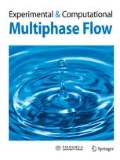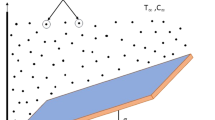Abstract
Deaeration is a process of eliminating aspirated air from liquid in hydraulic reservoirs to avoid cavitation in the downstream pump blades. The complex fluid dynamics associated with deaeration is investigated. The three-dimensional buoyancy driven chaotic behavior of gas-liquid interfacial two-phase flow is studied. Parametric study is executed to understand change in internal flow physics (bubble coalescence, disintegration, horizontal spread, bubble velocity etc.), strength of accelerating Rayleigh-Taylor instability, turbulent kinetic energy, amplitude of upward velocity near free surface, and rise in free surface level with the variation of parameters like incoming mixture flow rate, incoming volume fraction of air, liquid fill depth, and Atwood number. The computations show increment in cavitation, wavenumber and amplitude of upward velocity towards oscillating free surface with incoming flow rate (Re). Cavitation and free surface instability show incremental trend with volume fraction of incoming air forming a kink (cavitation reduces) due to bubble coalescence in a threshold range of volume fraction of incoming air. With the variation of Atwood number, initially cavitation reduces. But after a critical value (A*) of Atwood number, effect of bubble disintegration, and rise of cavitation become prominent, which is formulated with respect to incoming flow rate (Re). With liquid fill depth, cavitation shows a slight decrement with almost equal deaeration and constant wavelength of free surface oscillation at an increasing buoyancy driven upward velocity. Some glimpse of design solution to reduce the cavitation and enhance the deaeration is also studied and formulated to get better understanding.
Similar content being viewed by others
Change history
05 February 2022
A Correction to this paper has been published: https://doi.org/10.1007/s42757-022-0132-z
References
Balasubramaniam, R., Ramé, E., Kizito, J., Kassemi, M. 2014. Two phase flow modeling: Summary of flow regimes and pressure drop correlations in reduced and partial gravity. National Center for Space Exploration Research, Cleveland, Ohio, USA.
Bellman, R., Pennington, R. H. 1954. Effects of surface tension and viscosity on Taylor instability. Q Appl Math, 12: 151–162.
CD-adapco Group (CDA). 2018. STAR-CCM+ Users Guide, Release 13.06.013. Melville, New York, USA.
Chandrasekhar, S. 1961. Hydrodynamic and Hydromagnetic Stability. Oxford University Press.
Chou, Y., Shao, Y. 2016. Numerical study of particle-induced Rayleigh-Taylor instability: Effects of particle settling and entrainment. Phys Fluids, 28: 043302.
Contopoulos, I., Kazanas, D., Papadopoulos, D. B. 2016. The magnetic Rayleigh-Taylor instability in astrophysical discs. Mon Not R Astron Soc, 462: 565–575.
Duff, R. E., Harlow, F. H., Hirt, C. W. 1962. Effects of diffusion on interface instability between gases. Phys Fluids, 5: 417–425.
Gorash, Y., Bickley, A., Gozalo, F. 2018. Application of the CEL approach to consider FSI for the assessment of leak tightness for elastomeric seals. In: Proceedings of the ASME 2018 Pressure Vessels and Piping Conference. Volume 4: Fluid-Structure Interaction, PVP2018-84792.
Guo, H. Y., Wang, L. F., Ye, W. H., Wu, J. F., Zhang, W. Y. 2017. Weakly nonlinear Rayleigh-Taylor instability in incompressible fluids with surface tension. Chinese Phys Lett, 34: 045201.
Hibiki, T., Ishii, M. 2001. Interfacial area concentration in steady fully-developed bubbly flow. Int J Heat Mass Tran, 44: 3443–3461.
Hibiki, T., Ishii, M. 2002. Interfacial area concentration of bubbly flow systems. Chem Eng Sci, 57: 3967–3977.
Hu, Z. X., Zhang, Y. S., Tian, B., He, Z., Li, L. 2019. Effect of viscosity on two-dimensional single-mode Rayleigh-Taylor instability during and after the reacceleration stage. Phys Fluids, 31: 104108.
Ingvast, H., Norberg, A. 2012. Unit for accumulating and degassing oil. United States Patent, US 8,118,921 B2.
Joggerst, C. C., Almgren, A., Woosley, S. E. 2010. Three-dimensional simulations of Rayleigh-Taylor mixing in core-collapse supernovae. Astrophys J Lett, 723: 353–363.
Kawaguchi, M., Niga, S., Gou, N., Miyake, K. 2006. Buoyancy-driven path instabilities of bubble rising in simple and polymer solutions of hele-shaw cell. J Phys Soc Jpn, 75: 124401.
Kirkpatrick, R. D., Lockett, M. J. 1974. The influence of approach velocity on bubble coalescence. Chem Eng Sci, 29: 2363–2373.
Kocamustafaogullari, G., Ishii, M. 1995. Foundation of the interfacial area transport equation and its closure relations. Int J Heat Mass Tran, 38: 481–493.
Le Creurer, B., Gauthier, S. 2008. A return toward equilibrium in a 2D Rayleigh-Taylor instability for compressible fluids with a multidomain adaptive Chebyshev method. Theor Comp Fluid Dyn, 22: 125–144.
Lewis, D. J. 1950. The instability of liquid surfaces when accelerated in a direction perpendicular to their planes. II. P Roy Soc A: Math Phy, 202: 81–96.
Li, S. M., Zhang, A. M., Wang, Q. X., Zhang, S. 2019. The jet characteristics of bubbles near mixed boundaries. Phys Fluids, 31: 107105.
Loisy, A., Naso, A., Spelt, P. D. M. 2017. Buoyancy-driven bubbly flows: Ordered and free rise at small and intermediate volume fraction. J Fluid Mech, 816: 94–141.
Magolan, B., Baglietto, E. 2019. Assembling a bubble-induced turbulence model incorporating physcial understanding from DNS. Int J Multiphase Flow, 116: 185–202.
Magolan, B., Lubchenko, N., Baglietto, E. 2019. A quantitative and generalized assessment of bubble-induced turbulence models for gas-liquid systems. Chem Eng Sci: X, 2: 100009.
Morgan, R. V., Likhachev, O. A., Jacobs, J. W. 2016. Rarefaction-driven Rayleigh-Taylor instability. Part 1. Diffuse-interface linear stability measurements and theory. J Fluid Mech, 791: 34–60.
Oakley, J. 2004. Rayleigh-Taylor instability notes. Available at http://silver.neep.wisc.edu/~shock/rtnotes.pdf.
Oolman, T. O., Blanch, H. W. 1986. Bubble coalescence in stagnant liquids. Chem Eng Commun, 43: 237–261.
Plesset, M. S. 1974. Viscous effects in Rayleigh-Taylor instability. Phys Fluids, 17: 1.
Plesset, M. S., Hsieh, D. Y. 1964. General analysis of the stability of superposed fluids. Phys Fluids, 7: 1099–1108.
Prince, M. J., Blanch, H. W. 1990. Bubble coalescence and break-up in air-sparged bubble columns. AIChE J, 36: 1485–1499.
Ramaprabhu, P., Dimonte, G., Woodward, P., Fryer, C., Rockefeller, G., Muthuraman, K., Lin, P. H., Jayaraj, J. 2012. The late-time dynamics of the single-mode Rayleigh-Taylor instability. Phys Fluids, 24: 074107.
Rayleigh, L. 1883. Analytic solutions of the Rayleigh equation for linear density profiles. Proc London Math Soc, 14: 170–177.
Regan, S. P., Epstein, R., Hammel, B. A., Suter, L. J., Ralph, J., Scott, H., Barrios, M. A., Bradley, D. K., Callahan, D. A., Cerjan, C. et al. 2012. Hot-spot mix in ignition-scale implosions on the NIF. Phys Plasmas, 19: 056307.
Roache, P. J. 1997. Quantification of uncertainty in computational fluid dynamics. Annu Rev Fluid Mech, 29: 123–160.
Sanderson, R. M., Davison, J. L. 2004. Hydraulic pump reservoir having deaeration diffuser. United States Patent, US 6,783,334 B2.
Shelke, N., Bade, A., Mukhopadhyay, S. 2019. Fluid-structure interaction-based simulation methods for fluid sloshing in tanks. SAE Technical Paper, 2019-01-5091.
Smalyuk, V. A. 2012. Experimental techniques for measuring Rayleigh-Taylor instability in inertial confinement fusion. Physica Scripta, 86: 058204.
Taylor, G. I. 1950. The instability of liquid surfaces when accelerated in a direction perpendicular to their planes. I. P Roy Soc A: Math Phy, 201: 192–196.
Tejashwar Reddy, V. 2017. CFD analysis of sloshing within a tank with porous baffles. Int J Sci Res, 6: 172–177.
Terrones, G., Carrara, M. D. 2015. Rayleigh-Taylor instability at spherical interfaces between viscous fluids: Fluid/vacuum interface. Phys Fluids, 27: 054105.
Tic, V., Lovrec, D. 2012. Design of modern hydraulic tank using fluid flow simulation. Int J Simul Model, 11: 77–88.
Vijay Kumar, K., Kantha Rao, K. 2017. Exploration of air flow inside oil tanks by using CFD. Int J Adv Infor Sci Tech, 6: 70–77.
Wei, T., Livescu, D. 2012. Late-time quadratic growth in single-mode Rayleigh-Taylor instability. Phys Rev E, 86: 046405.
Wolf, G. G. H. 2018. Dynamic stabilization of the Rayleigh-Taylor instability of miscible liquids and the related “frozen waves”. Phys Fluids, 30: 021701.
Yamanaka, C. 1999. Inertial confinement fusion: The quest for ignition and energy gain using indirect drive. Nucl Fusion, 39: 825–827.
Zahedi, P., Saleh, R., Moreno-Atanasio, R., Yousefi, K. 2014. Influence of fluid properties on bubble formation, detachment, rising and collapse; Investigation using volume of fluid method. Korean J Chem Eng, 31: 1349–1361.
Zhou, Y., Cabot, W. H. 2019. Time-dependent study of anisotropy in Rayleigh-Taylor instability induced turbulent flows with a variety of density ratios. Physics Fluids, 31: 084106.
Ziegenhein, T. 2016. Fluid dynamics of bubbly flows. Ph.D. Thesis. Process Sciences of the Technical University, Berlin.
Acknowledgements
The authors would like to acknowledge John Deere India Private Limited for constant support of providing the computational resources to execute this study and Mrs. Shatarupa Roy, Mr. Shyam Chaturvedi, and Mr. Svidal Trond A for constantly encouragement and motivation.
Author information
Authors and Affiliations
Corresponding author
Electronic Supplementary Material
Rights and permissions
About this article
Cite this article
Mukhopadhyay, S., Nimbalkar, G. Fundamental study on chaotic transition of two-phase flow regime and free surface instability in gas deaeration process. Exp. Comput. Multiph. Flow 3, 258–288 (2021). https://doi.org/10.1007/s42757-020-0065-3
Received:
Revised:
Accepted:
Published:
Issue Date:
DOI: https://doi.org/10.1007/s42757-020-0065-3




